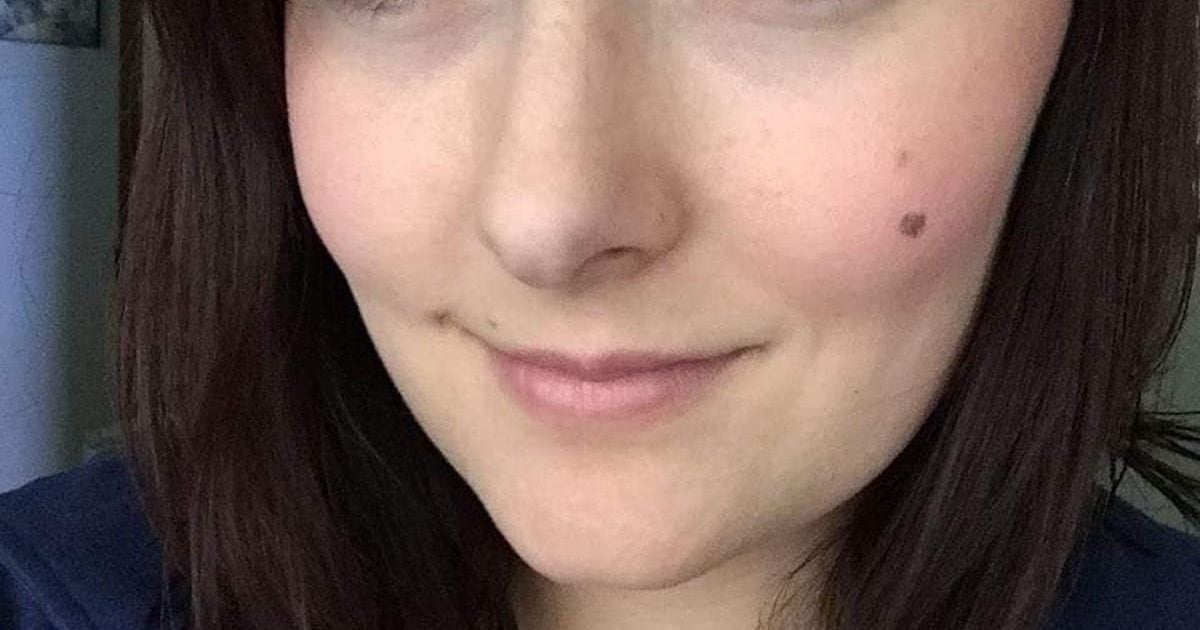Lifesaving Tips From A Skin Cancer Survivor
- Kayla Robinson is sharing her skin cancer story with others in hopes that they will pay closer attention to any concerning spots or moles on their bodies and schedule regular screenings with a doctor dermatologist. Diagnosed with melanoma at 27, she is now cancer-free at 31.
- She went to the doctor when her heart-shaped freckle began to turn into a dark brown mole and lose its shape. After undergoing Mohs surgery, the aggressive cancer was removed and she now gets screened every six months. Robinson never tanned and spends little time in the sun.
- Mohs surgery involves slicing off the skin’s tissue layer by layer and then examining each layer with a microscope. The doctor cuts the layers deeper and deeper until there is a transparent layer, which means the cancer cells are gone from that area. That process all happens in real-time, giving patients peace of mind.
Kayla Robinson is now sharing her story with others in hopes that they will pay closer attention to any concerning spots or moles on their bodies and schedule regular screenings with a dermatologist.
Read More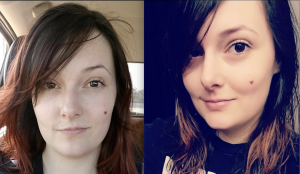
“From at least 6th grade, I had a mole on my cheek, and right below it was a flat freckle. Over time that flat freckle became more and more prominent. By the time I was 26, it had formed into a heart shape and was super cute,” writes Robinson in a Facebook post detailing her journey.
“However, when I was 27, it had started to rapidly change and was no longer the perfect heart shape. It went from being a medium-dark chocolate brown to brown-black, and the heart had lost some of its shape.”
That is when Robinson decided that the best course of action would be for her to see a doctor, who recommended that she see a dermatologist.
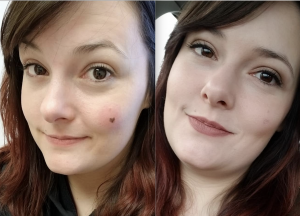
At that appointment, the dermatologist did a biopsy of the mole after getting Robinson’s approval.
“My heart-shaped freckle was really cute… I got a lot of compliments on it… Even people asking me if it was a tattoo, So cute,” Robinson remembered thinking at the time.
“But… what if it was more, what if, what if, what if.”
In the end, she opted for a biopsy of the entire mole, which meant that after her face was numb and her heart scraped away, it went to the lab.
Robinson’s lack of vanity at that moment may have saved her life, as a short while later, she learned that it was skin cancer.
She was getting ready to head to work at the jail, where she worked the night shift when she got the call.
“Mind you, my memory is a bit hazy on the scientific words, but it went a little like this. ‘I usually want to schedule an appointment to go over results, but this couldn’t wait. You have a highly aggressive form of melanoma. I have scheduled you already for the first available appointments at the surgery center in Seattle, and then the plastic surgery that will need to follow,'” recalled Robinson.
“I was sobbing in my bathroom.”
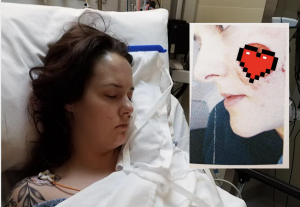
Related: Disgraced Pitcher Roger Clemens Says Baseball Players at Risk of Skin Cancer Under 'Sunscreen Ban'
She did not delay treatment, though, and soon after, she took her mom and headed up to Seattle for surgery.
It was Mohs surgery which is outpatient and meant that Robinson witnessed the entire procedure.
“They put me on a chair, much like a dentist chair, and reclined me back. They cleaned the area and began injecting my cheek with stuff to make it numb. They were poking me so many times that I started to count (after they had already done it at least ten times). I got to 40 or 50 something before I completely lost count and gave up,” she said.
“Then they started to cut a circle on my cheek around the cancer, and as they did it, I could still feel the cuts near my nose, so they had to poke me more (through my opened wound). Then they peeled it off my face. Nothing quite like watching your skin be filleted off👀. I could see the yellow layer of fat that went with it, leaving a gaping bleeding hole in my face that was the size of, and looked like, a pepperoni.”
The following day she learned the surgery was a success, and the day after that, she had the plastic surgery needed to repair the large hole in her face.
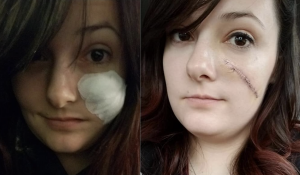
“They were unable to find a vein in my arm (probably because I was dehydrated from violently throwing up all night… imagine that), and they had to put the IV in my hand. Ouch! It was bruised for about a week after,” said Robinson.
“Anyway, they roll me back and put the gas on me, telling me to start counting. I was somewhere around ten before the next thing I knew, I woke up in the room they prepped me in, with a railroad of stitches in my face.”
Had she never had that heart-shaped mole checked, things would likely be different, which is why she is committed to spreading the word about screenings and self-examinations.
She gets checked every month and warns everyone that she never tanned or spent much time in the sun aside from her early childhood running around outside in Alabama.
“So….Wear sunscreen (reapply every 2 hours) and/or protective clothing, do your yard work when the UV isn’t strong, get suspicious things checked by a professional, live a life you love, and love the life you live,” said cancer-survivor-turned-lifesaver Robinson in closing.
What Is Mohs Surgery?
Dr. Frederick Mohs began to perform a procedure he referred to as chemosurgery in the 1930s that involved removing layers of tissue in surgical techniques and then examining them for signs of disease. His practices were later updated and slightly changed so that doctors could use his method to treat dermatological conditions, including skin cancers, thus giving the world Mohs surgery.
The procedure is quick, highly effective, and performed as an outpatient surgery.
A surgeon will begin by slicing off the skin’s tissue layer by layer and giving them to a pathologist or personally examining them with a microscope.
The doctor cuts the layers deeper and deeper until there is a transparent layer, which means the cancer cells are gone from that area.
That process all happens in real-time, giving patients peace of mind after they complete the surgery.
“So with most surgical procedures, you are taking a margin of healthy tissue, healthy skin around the tumor. And that margin is something that we come to as a standard of care based on lots of studies, literature, our experience. And so this is not necessarily an arbitrary margin, but a standard margin that we take around the cancer,” explained Dr. Sumaira Aasi, professor of dermatology and director of Mohs and Dermatologic Surgery at Stanford, in a previous interview with SurvivorNet.
“And then that tumor is sent to a laboratory where it’s most often bread-loafed or sectioned. And the pathologist will look at various parts of this excised tumor and let the surgeon know whether they got it all out or not.”
That entire process is simplified and streamlined, however, for patients receiving Mohs surgery.
“With Mohs surgery, when we cut the tissue, we’re actually cutting it and looking at 100 percent of the margin. That really is what defines Mohs surgery from other excisional or tumor extirpation procedures,” said Dr. Asai.
Mohs Surgery Removes Skin Cancer With Smaller Incisions and More Certainty
Examining Your Skin for Melanoma: Remember ABCDE
Kayla Robinson discovered her cancer by doing a self-check.
She will continue to do them because she knows better than anyone now that finding skin cancer early can save a person’s life.
Dr. Cecilia Larocca, a dermatologist at Dana-Farber Cancer Institute, recommends looking at your skin once a month for anything suspiciousand using the acronym ABCDE as a checklist:
Asymmetrical moles: if you drew a line straight down the center of the mole, would the sides match?
Borders: irregular, jagged, not smooth; can also stand for bleeding
Colors: multiple distinct colors in the mole
Diameter: larger than 6mm, about the size of a pencil head eraser
Evolution: This may be the most important thing that changes over time, such as gaining color, losing color, pain, itching, hurting, changing shape, etc.
Checking for Signs of Melanoma
Learn more about SurvivorNet's rigorous medical review process.

